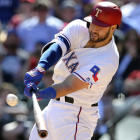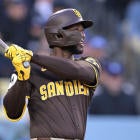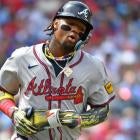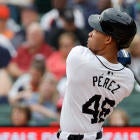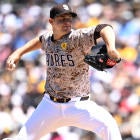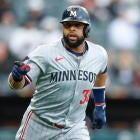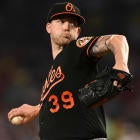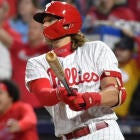When it comes to power, we're really talking about two different things. In the broadest sense, we're talking about how hard a player can hit a baseball. Raw power is what shows up in batting practice, or a home run derby.
That's a useful tool, but it doesn't mean much if you can't put it into action. Turning raw power into game power requires the ability to put the bat on the ball consistently, in such a way that creates the type of batted balls likely to go over the fence -- line drives and flyballs, namely.
There may be no player in professional baseball who has personified the difference between raw power as a tool and power as a tangible, useful skill in a baseball game than Joey Gallo. Standing in at a Stanton-ian 6-foot-5, 235 pounds, Gallo had little trouble producing in the minors -- even with an almost unprecedented strikeout tendency -- but his inability to make contact really hampered him in his first two stints in the majors. He hit just .173/.281/.368 in 153 plate appearances between 2015 and 2016, while striking out in a whopping 49.7 percent of his plate appearances.
His weaknesses were so glaring that it hardly looked like he was going to get a chance to prove himself again, at least to start the season. However, an injury to Adrian Beltre opened up a path to playing time to open the season, and Gallo has mashed six homers and 14 RBI in his first 19 games. Yes, it has come with just a .213 batting average, but Gallo is clearly back on Fantasy radars, and it's fair to ask at this point both whether he figures into the Rangers' long-term plans this season, and how much Fantasy players can reasonably expect from him.
First things first, it's worth asking if Gallo can improve on his .213 batting average, because if he can't, everything else might be a moot point. Gallo is always going to strike out, and he's always going to have a lot of swing and miss in his game, but he has improved in this regard in the early going. He has seen 298 pitches in the first 19 games of the season and has swung-and-missed at 15.8 percent of them, a pretty dramatic improvement on the 22.1 percent mark he posted in his first two stints in the major.
Gallo is swinging at more pitches inside of the strike zone, which helps, and he has increased his contact percentage when he does swing from around 50 percent to 66.7. That would still be one of the worst marks in baseball, but it represents a substantial improvement, putting him more in the Miguel Sano or Giancarlo Stanton range. Both have strikeout issues, but both have also managed batting averages in the .270 range (higher in Stanton's case) because they hit so many balls over the fence, and generally have a lot of success on batted balls.
If you can hit the ball hard enough, that kind of contact rate can play, and Gallo has at least cleared that hurdle. And boy, does he hit the ball hard. Sano has been in a league of his own when it comes to hitting the ball hard, but Gallo is doing his damnedest to catch up, highlighted by the hardest hit homer of the Statcast era over the weekend:
He now ranks second in the majors in average exit velocity, at 97.3 MPH, and thanks to his 23.1 percent average launch angle, Gallo's average batted ball flies 263 feet, second longest in the majors, per Statcast data. He also sports a 51.4 percent hard-hit rate, so there's no question he hits the ball hard.
And yet, that .213 average is dragged down by a .241 BABIP, a far cry from Stanton's .322 rate or Sano's .355 mark. Part of this is on Gallo, because he hits so many flyballs. His 62.9 percent flyball rate is one of the highest in the majors, and flyballs that don't go for home runs tend to be caught -- flyballs had a collective .127 BABIP last season. Over the last 10 seasons, only eight players have managed a flyball rate over 55 percent in at least 200 plate appearances, and they have managed a .250 BABIP between them.
Gallo is always going to be an all-or-nothing hitter, and the hope is you'll get enough all to balance out the nothing. He might be too much of a drain on your batting average to justify playing too much, but for the first time in his career, it's at least a question. Gallo's power is no longer theoretical, and there's legitimate 40-homer upside here, even given his contact issues. Even when Beltre comes back, Gallo has hit enough to justify a spot in the Rangers' lineup, and probably needs to be owned in all Fantasy formats after this start.













